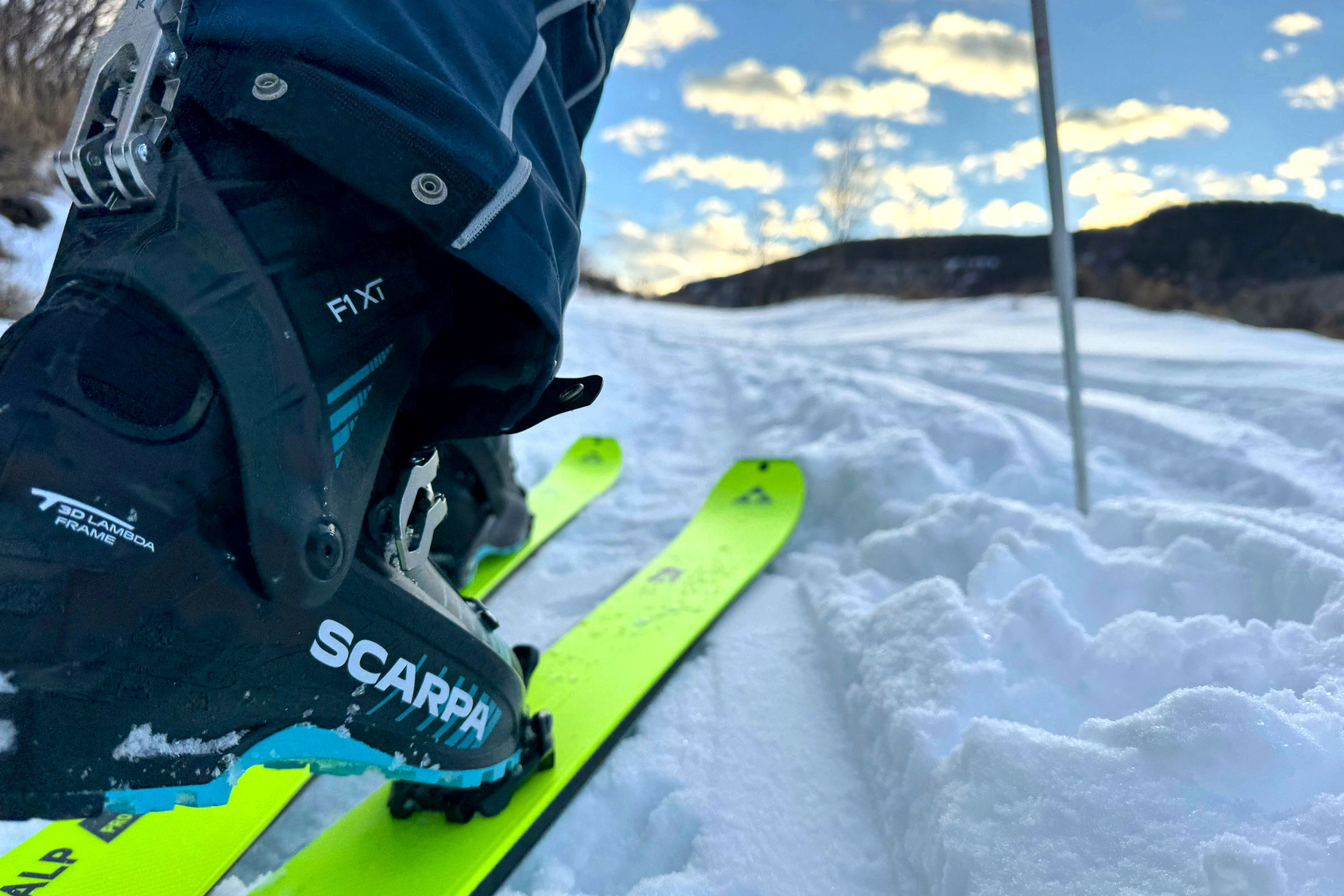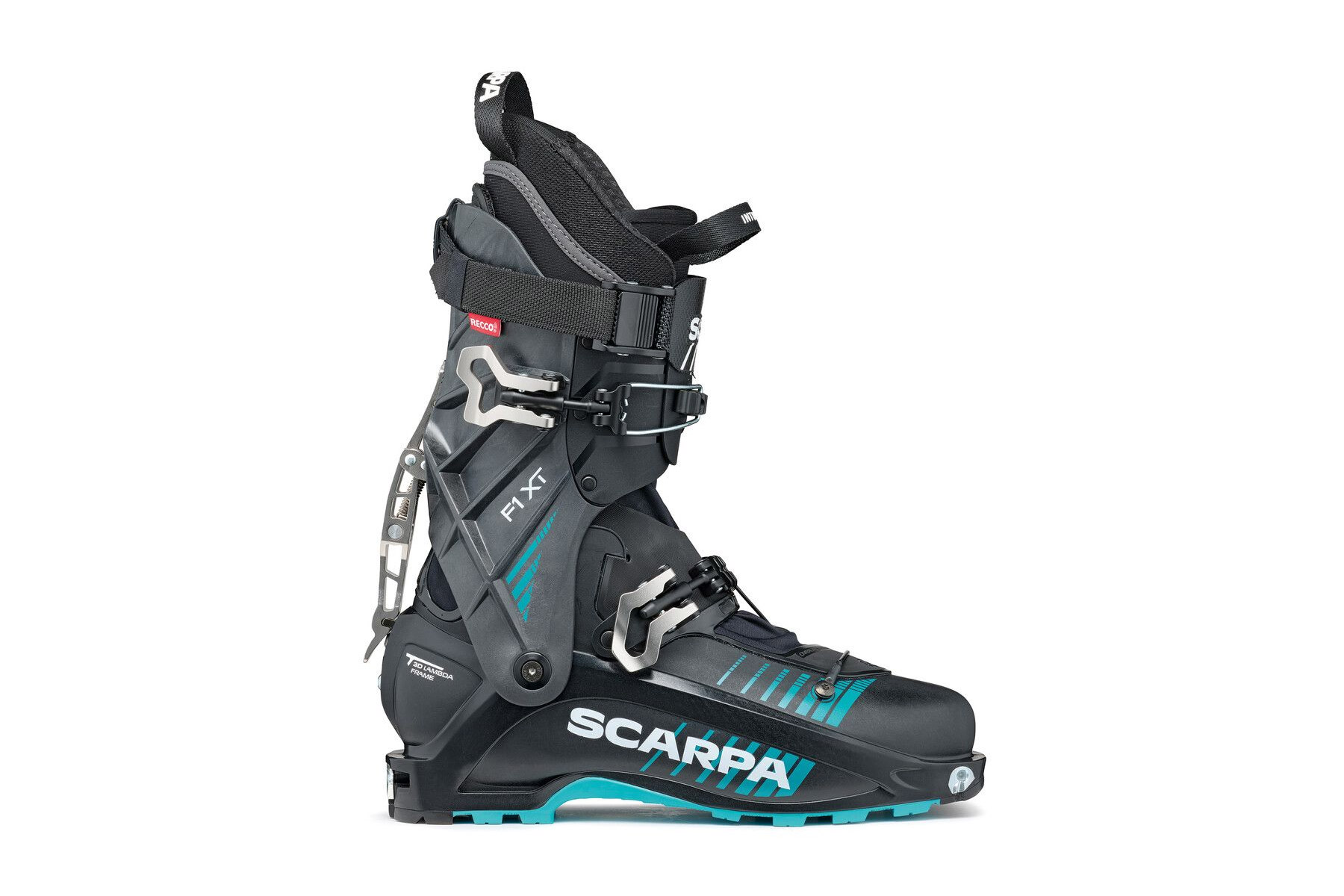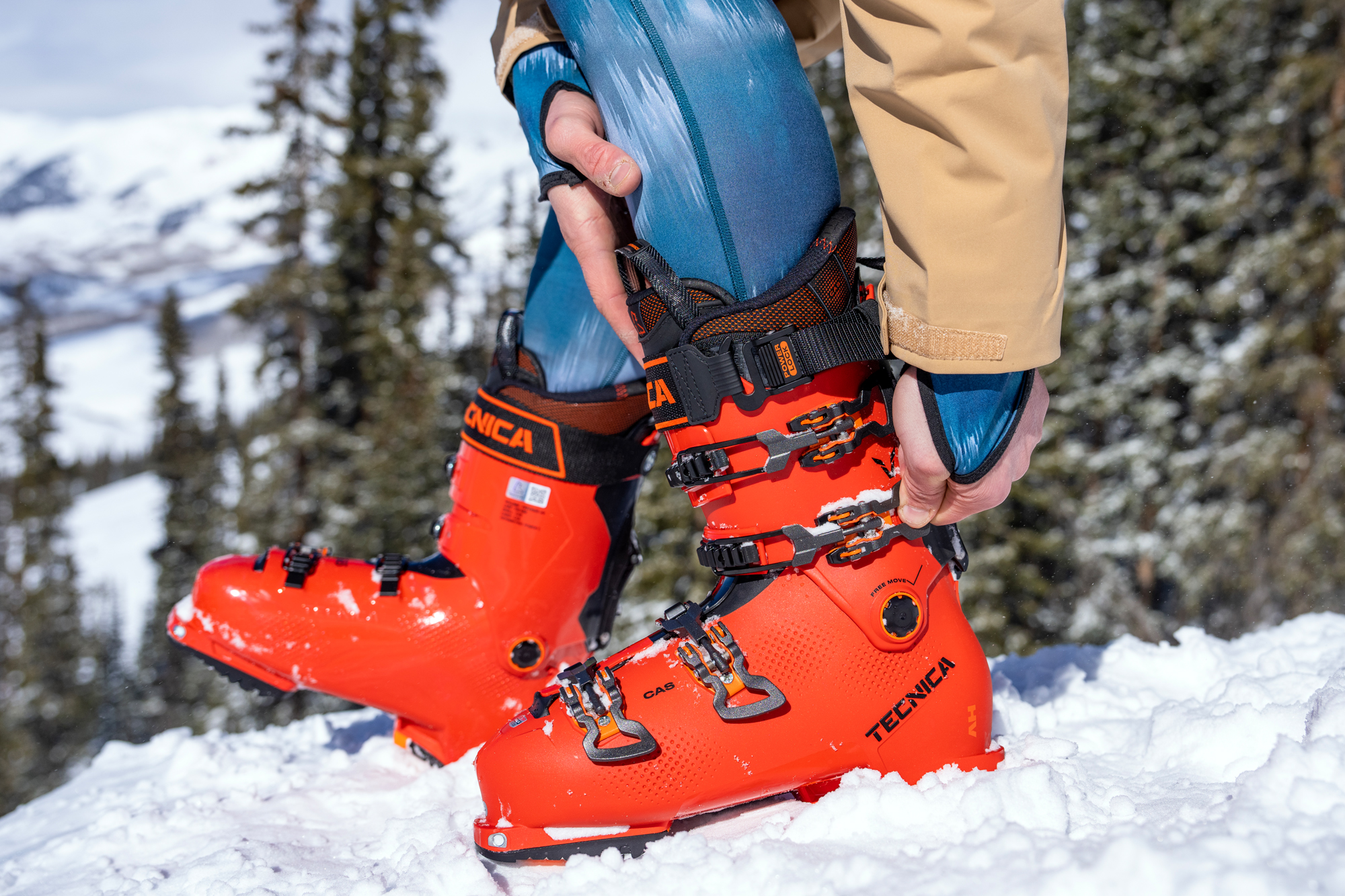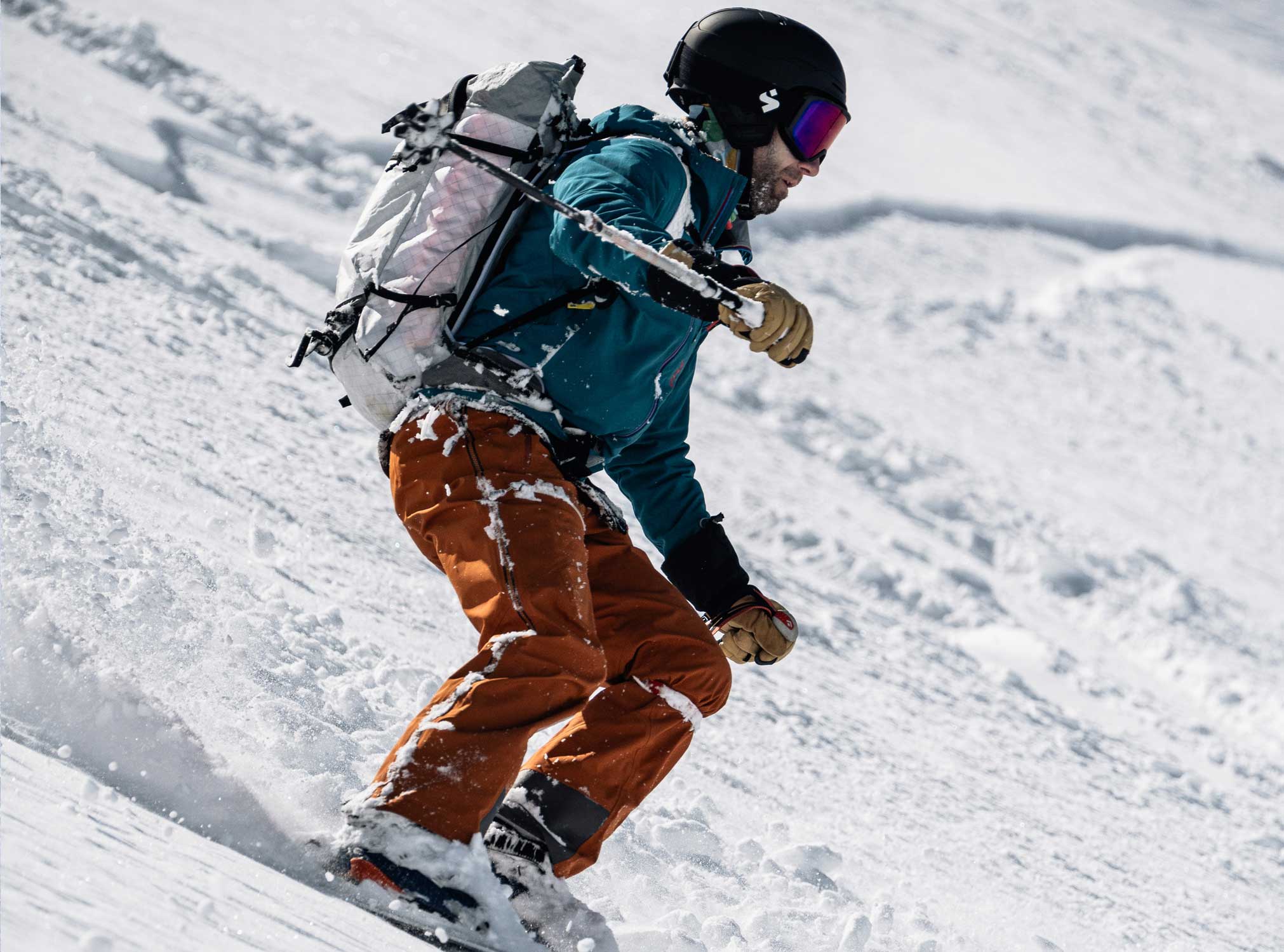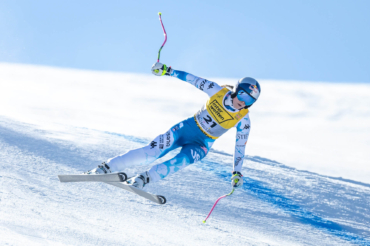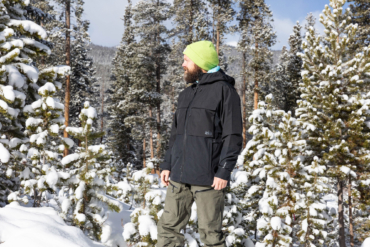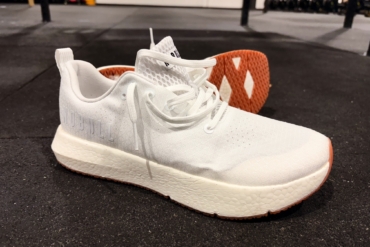When the snow started falling this season, it came in a big way. Overnight, it seemed to go from bone dry to a fluffy winterland. My legs weren’t prepared to match my powder fever and the endless laps I had envisioned. I was testing SCARPA’s new ultralight SCARPA F1 XT Ski Touring Boot, and good thing, too. The featherweight boots and their running shoe-like articulation gave me the boost that my early-season legs couldn’t.
Every time SCARPA comes out with a new boot, I think, “Now, this one is the best in the business; it probably can’t get much better.” That’s what I thought about my first Maestrale, my F1, the Alien RS, and then the F1 LT.
But alas, a new boot just landed in North America from the Italian brand and it’s once again outdone itself. The F1 XT takes the best features of all my favorite Scarpa’s before it and ditches the flops.
In short: SCARPA has dominated the lightweight ski touring boot scene for more than a decade and its designs continue to evolve. The new F1 XTs are mega-light boots that build off the cult-favorite Alien RS and F1 LT while enhancing the downhill performance. Sure, they gained a little weight, but the extra grams are thoughtfully employed in adding more progressive flex over their more rigid forebears and reverting to a tried-and-true buckle layout. Clearly, designers at SCARPA have been listening to feedback and they’ve acted on it. The F1 XTs are the best F1 yet for a wider variety of backcountry skiers.
- Size options: 23-31 (whole sizes)
- Weight: 1,145 g; 2 lbs., 8.4 oz. (1/2 pair size 27)
- Liner: Intuition Tour L T2
- Last: 100mm
- Outsole: Vibram UFO LT
- Shell: Grilamid FG LFT
- Cuff: Carbon Grilamid
- Tongue: Soft tongue
- Flex: 95
- Forward lean: 11°/13°/15° +/- 2° with spoiler
- Range of motion: 72º
- Closure: 2 Buckle Wave Light Closure + Cam Buckle Power Strap
- Binding system: Tech only
Pros
- Tried-and-true buckle layout
- Integrated gaiter
- Huge frictionless range of motion in walk mode
- Enough power for medium-size touring skis
- Comfortable fit for a broad range of foot shapes
Cons
- Not a good match for big freeride skis
- Dialing back the speed required in hard snow conditions
SCARPA F1 XT Ski Touring Boot Review
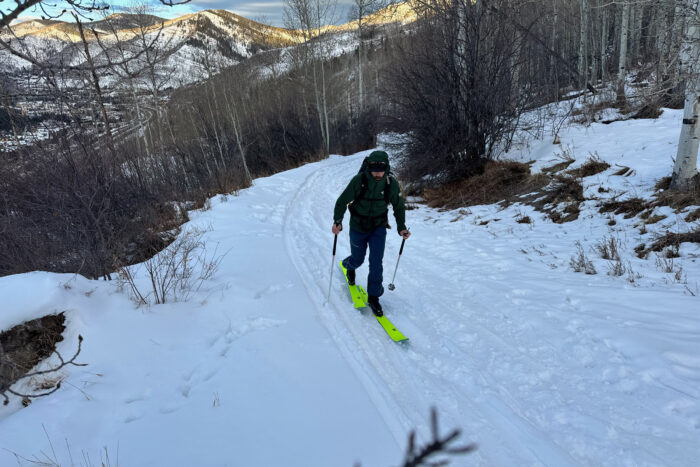
Skinning in the F1 XT
It didn’t take long for me to get on board with the F1 XT’s touring capability. It was my first tour of the season right as a big storm rolled through. The F1 XT’s tour effortlessly like a race boot. There’s almost no discernable friction coming from the cuff when fully unbuckled. I could slide my ski a full stride forward, and the cuff had more range to give than my ankle. The same goes for the back ski — I couldn’t feel a limit from the boot.
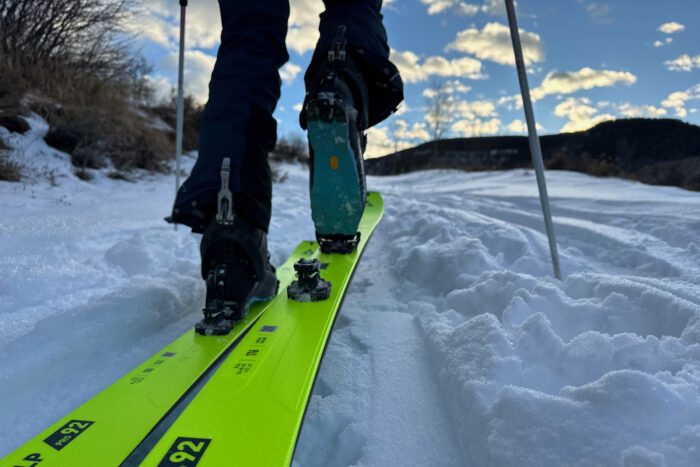
I’ve been in love with the XT’s uphill performance as I’ve dialed in the fit over the past few weeks. Their 100mm lasts feel adequately roomy without being sloppy. Though, I added heel wedges under the liners and a fresh pair of Superfeet’s new Winter Thin Support insoles like I do with every touring boot to help mitigate heel lift.
I haven’t found the need to mold the liners. For reference, I’m a 10-10.5 U.S. men’s street shoe, and the 28 F1 XTs fit how they should.
I was impressed with their comfortable movement even during longer days on the skin track. I never had to apply Leukotape to prevent blisters on my heel. The boot’s massive range of motion and low-profile fit meant my foot wasn’t sliding around to compensate.
They’re also super easy to get into, which will be welcome news to all the high-arched skiers out there.
Skiing the F1 XT
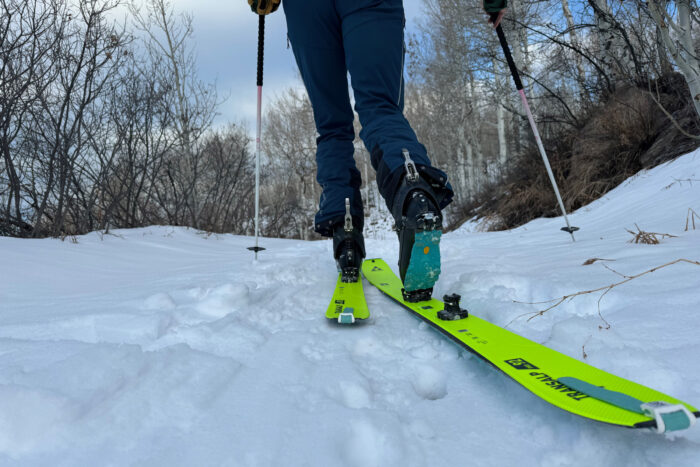
I paired the boot with my current favorite lightweight touring skis: Fischer’s new Transalp 92 CTIs mounted with Marker’s Alpinist 12 bindings. They’ve been a great match for the new SCARPAs. They’re modest in the waist (92mm) and easy to control for such a light boot. But they have the torsional stiffness and power to lay down an arc.
The F1 XT was able to pilot that ski through a wide variety of conditions. They’re capable of being so minimal. They didn’t fold readily like some lightweight boots do. They also didn’t feel as abrupt or harsh as full carbon boots can. Instead, they have an impressively smooth, yet short, progressive ramp-up. At the end of that ramp-up was an ample tongue to push into to keep them riding high.
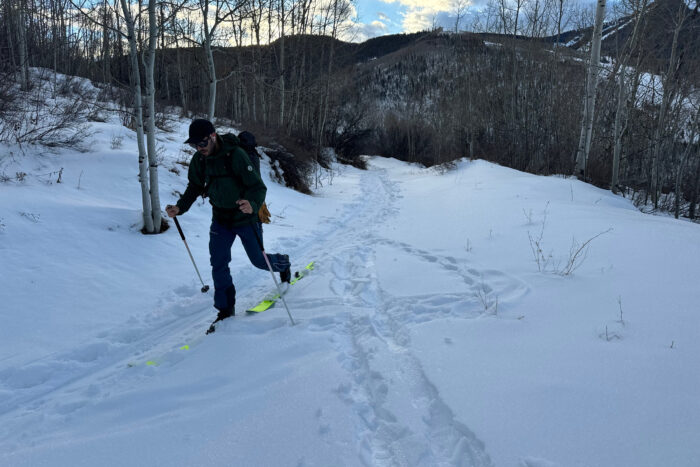
I felt confident opening the throttle in predictable and smooth conditions. I was able to lean into the tongues to test their flex under pressure at the ski resort. On fresh corduroy, I carved full blast and pushed all my weight into them and they energetically pushed back.
I did manage to push past the top of the progressive ramp-up in the resort, though, which is soft on the other side, almost like a bell curve — but only when slamming into hardpack moguls and other high-speed compressions in firm conditions.
It was the first time I noticed the boot’s softness compared to heavier touring boots. So yeah, they aren’t freeride boots. They quickly regained their composure when I dialed back the speed, though.
They held up high in the flex range and felt consistently supportive over mixed terrain in the backcountry. This was helpful when I had a heavy pack on my back. They provided just the stability I needed.
I was impressed with their performance on steep ice and hard pack as well. The F1 XTs were able to take full advantage of the Transalp 92 CTI’s rock-solid torsional rigidity in jump turns without flexing laterally. They landed on their edges without any slop or excess sliding. When I leaned the edges into the slope, the boots held them confidently. That’s welcome news for skiing zesty spring couloirs.
The F1 Evolution
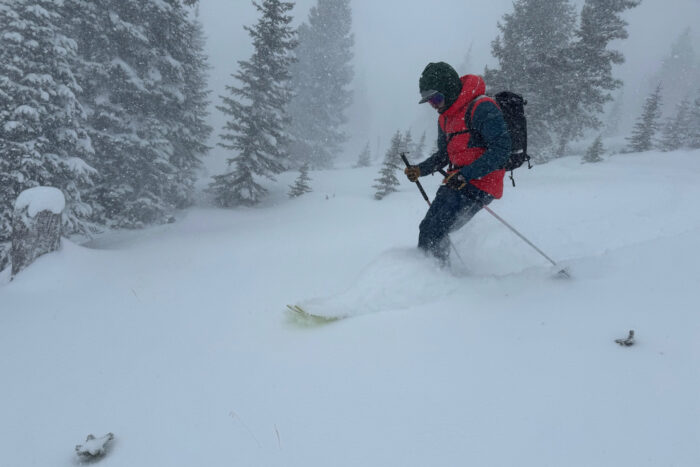
SCARPA’s F1 XT is the third iteration of its venerable Alien RS chassis that came out in 2017. That boot had a cult following thanks to its frictionless 72-degree walk mode, quick transition via integrated ski lock tightening, sufficient downhill performance, and scant 983g weight (size 28). It was essentially a race boot that performed in the backcountry, too.
The bar was set high for the next boot, the F1 LT, which aimed to increase downhill performance by adopting some of the backcountry-oriented F1’s features while maintaining the massive range of motion, stiff carbon grilamid, and lambda frame structure of the Alien RS. They were able to maintain a sub-1kg package at 990g (size 27) and a stiff-for-a-light-boot 100 flex rating.
But here’s the rub: they took my least favorite features of the otherwise solid F1. The Velcro strap top buckle and the BOA instep dial both remained.
Last season, SCARPA launched the F1 GT, which left the Velcro strap and BOA dial in the dust in favor of traditional ski boot buckles and built the boot from a slightly softer but more progressive Grilamid with fiberglass reinforcements. It also received a slightly heavier liner in the Intuition Tour LT2. It gained a little weight at 1,165 g and got a little bit softer at an estimated 90 flex.
F1 XT Chassis
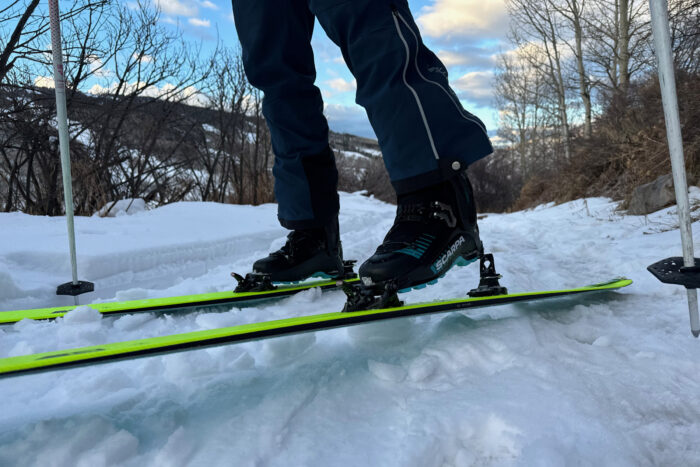
Enter the just-released-in-North-America F1 XT, a stiffer, more aggressive, and progressive iteration. They boast a slightly stiffer flex (95) than the GT and go even lighter at 1,145 g in size 27. My size 28 F1 XT, with upgraded footbeds and heel shims, weighed in at 1,275 g.
The primary power gain over the GT comes from Carbon Grilamid cuffs, which are both stiffer and lighter than Grilamid Fiberglass cuffs. The XTs share the Grilamid Fiberglass shells of GT, though, which can deform more readily than carbon. The Grilamid Fiberglass is where the more enjoyable and progressive flex comes from.
The spring-loaded ski/walk lever carried over from previous F1s unchanged because it’s excellent. It pops open and closed with a simple flick. I haven’t had any trouble with snow or ice buildup blocking it yet.
Many will appreciate the integrated lean adjustment. It allows you to change the default 13-degree lean up to 15 degrees or down to 11 degrees. A spoiler attached to the liner also offers another 2 degrees of adjustment. The stock configuration has been perfect for my skiing stance.
A slick integrated gaiter melds into the boot’s shell to create a waterproof barrier. It allowed SCARPA to remove a lot of excess boot. Without that gaiter, you’d see a lot of liners exposed to the elements.
F1 XT Buckle System
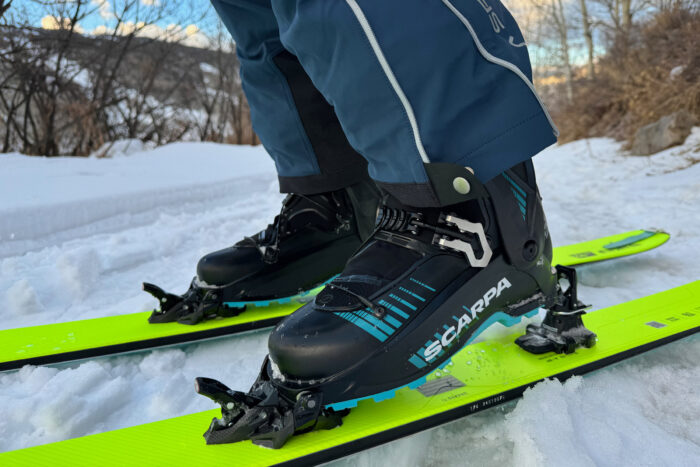
Here’s an unpopular opinion you may have picked up on: I don’t love BOAs on my ski touring footwear. It was my main gripe with the otherwise excellent La Sportiva Skorpius CR II boot, which falls in the same weight class as the F1 XT. The original SCARPA F1 suffered from the same thing.
I’ve never been able to get a BOA dial tight enough for that “locked-in” feel that my SCARPA Maestrales achieve with traditional buckles. That’s why the XTs caught my eye originally. They use traditional buckles that just work. But they’re also stiffer and more aggressive than the F1 GT, which also bailed on BOA and Velcro in favor of buckles.
On the lower part of the boot, a Z cable leverages more tension over a wider area than a typical buckle could. I’m always wary of a buckle that sits right on top of my mega-high arches. But I found the tension even and I didn’t die of top-of-the-arch pain. I even left them tight while skinning.

The top buckle is strong and light, and it locks in the tension that I want. The hooked base has three bolt options drilled into the cuff. Even with thick ankles, I had to move them to the tightest setting right off the bat, but now I can get all the tension I need.
I do have one minor gripe in the buckle department, though. The top buckles do not lock open for touring as some boots do, and the keeper hook doesn’t keep the buckle’s wire attached under my pant cuff while skinning. When I left the buckle open, the buckle would either close by itself — limiting articulation slightly — or fully unhook itself. Neither of those two outcomes was that big of an issue, but consistency is better.
The new F1 XTs also employ booster-style power straps with cam locking mechanisms similar to what you’d see on freeride boots, just lighter at 34 g each. They’re a major fit and power boost over Velcro straps, which don’t do much to add stiffness or enhance fit.
Comparing the SCARPA F1 XT Ski Touring Boot
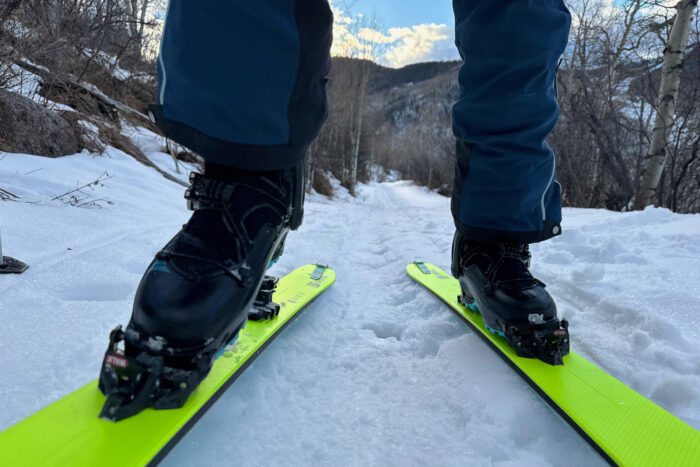
I’m not a fan of the Velcro strap buckle that the Scarpa F1, F1 LT, and the La Sportiva Skorpius CR II employ. It takes forever to get the tension I need to ski hard with a bigger ski. I’ve also found the setup gobbles up time at transitions because it requires so much tightening and retightening. The XT’s simple buckle layout is better.
Compared to the F1 and the Skorpius, the XT is less boot in terms of material and according to the scale. But the locked-in feel that the traditional buckles provide, and the resulting no-slip fit, make it ski like a more substantial boot than it is.
The Skorpius is a powerhouse of a lightweight touring boot, but the F1 XT isn’t far behind given the better tightening layout. The Skorpius’s higher-feeling cuff and thicker liner feel closer to a heavy-duty touring boot. The F1 XT, on the other hand, is 35 g lighter, transitions quicker, and has just a hair less resistance on the uphills.
SCARPA F1 XT Ski Touring Boot: Conclusion

The SCARPA F1 line of ski boots has included some of the best lightweight touring boots in the game. The new F1 XT is the best one yet, especially since the brand traded Velcro straps and BOA dials for buckles. Sure, they’re slightly heavier than their full carbon forebears, but the improved tensioning, transition time, and reduced fuss factor are worth every additional gram.
They’re solid in ski mode, especially when you’re piloting lightweight, moderately waisted skis like my Fischer Transalp 92 CTIs. The Carbon Grilamid cuff and Grilamid Fiberglass shell offer a good balance of stiffness and bulge (flex) that ski much friendlier than full carbon can offer.
I wouldn’t call them powerhouses. However, they’re formidable enough for big technical objectives, challenging conditions, and year-round human-powered skiing when paired with the right ski.
The frictionless and basically unlimited range of motion is what set their touring performance apart from others in their class. This is one of the few boots that can transition from the skimo racecourse to endless powder laps, to spring couloir hunting without much of a tradeoff in any venue.
